Newborn babies spend most of the day sleeping. During this period, they grow and actively develop. The fact how comfortable your sleep will be depends largely on the quality of the mattress. A variety of models of modern bedding, on the one hand, allows you to buy the perfect bed, and on the other hand, it can cause confusion among young parents. Consider which mattress is better to choose for a newborn, and also find out how to care for him.
When figuring out which children's mattresses are best for newborns, the first thing you should pay attention to is the type of construction. It can be spring or springless.
There are two types of spring models - with a dependent ("Bonnel") and an independent block. The first option is considered the least suitable for the child.. Due to the fact that the metal spirals are interconnected, pressure on one of them leads to sagging of the entire bed, and a "hammock effect" occurs. This is very harmful for the emerging children's spine. The only advantage of such a product is its low price.
An independent spring unit is a combination of many coils, each packed in a separate case.
Design advantages:
- when one of the elements deflects, the position of the others does not change, due to which the load is distributed evenly, and the child’s spine does not bend;
- when changing the position of the body, there are no vibrations throughout the canvas and no creaking is heard, since the springs do not contact each other.
The disadvantages of spring options include a lot of weight, the accumulation of static electricity, as well as the collection of dust inside.
Springless mattresses
Finding out which mattress is best for a newborn in a crib, you should opt for springless models made from modern materials. They do not have metal parts, and the support of the body in the anatomical position is achieved through the use of special fillers. The product can be made in the form of a monoblock of one material or be a stacked structure of several types of fibers. The most popular models are made of coconut coir and latex.
Coconut
If you ask the question of how to choose a mattress for a newborn, the recommendations of the pediatrician will indicate the benefits of products with a filler called coconut coir. The material is obtained from the peel of the fruit, and then impregnated with various substances to improve its consumer qualities.
Advantages of coconut coir mattresses:
- support of the spine due to the high level of rigidity;
- breathability;
- hypoallergenicity;
- resistance to moisture and decay, which is ensured by lignin, a polymer contained in palm fiber;
- antibacterial properties.
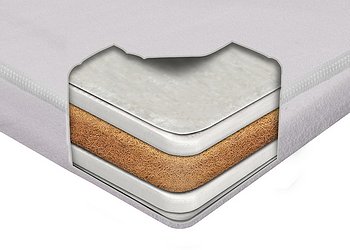
Coir does not accumulate odors, dust, insects do not breed in it. But all the positive characteristics are relevant only if the mattress filled with coconut fiber impregnated with natural latex. If the product contains synthetic rubber, it is not suitable for a child. Stitched mattresses made of pure coir without additives are short-lived, as it crumbles.
Latex
Considering which mattress to choose for a crib for a newborn, you should pay attention to springless products made from natural latex. The filler is made from the juice of the rubber tree (hevea). It is foamed and poured into special molds. The result is an elastic breathable material.

Advantages of latex mattresses:
- elasticity;
- resistance to moisture, fungus, insects;
- lack of creak;
- hypoallergenicity;
- bactericidal properties;
- durability;
- does not accumulate electrical charges.
Latex provides medium rigidity. In the first months of life, it is not enough. The ideal solution is a double-sided mattress made of coir and latex. The sides can be changed depending on the age of the baby and the time of year (latex is a warmer material). 
An analogue of natural latex is an artificial foamed polymer. It is much cheaper, but it can cause allergies in the baby due to the presence of chemical compounds in the composition.
Other fillers
When wondering which mattress is better for a newborn baby, you should know that they are also available with other fillers.
Possible options:
- Struttofiber is a non-woven material made from pressed woolen (or other natural) and synthetic (polyester) fibers. Warm like natural wool, but too soft for a newborn.
- Foam rubber (polyurethane foam) - foamed polymer. Hypoallergenic, stretchy, inexpensive, waterproof, but not tough enough.
- Horse hair from manes and tails. Resilient, tough, breathable, durable, but can cause allergies. To reduce allergenicity, special treatment is carried out.
- Algae are peeled and dried marine plants. Provides an average level of hardness and iodine evaporation, but is expensive and does not last long.
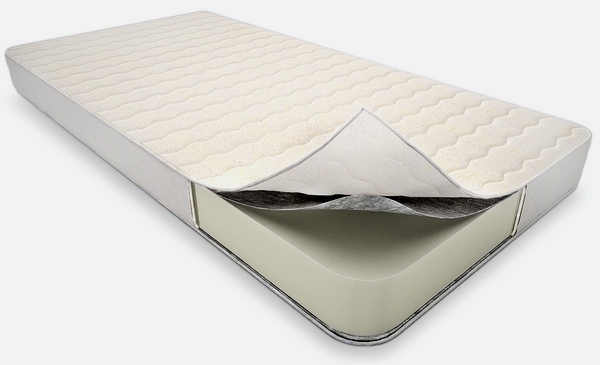
The listed materials are rarely used in their pure form in the manufacture of children's mattresses. Usually they are complemented with coir and / or latex. Batting, wood shavings, wool, straw, felt, cotton wool are not used in the production of bedding for babies. They can get wet and cause allergies, quickly deform and serve as a breeding ground for ticks.
The fillers described above are used not only in springless mattresses. In spring products, they are laid between metal elements and a cover in order to adjust the level of rigidity, as well as to ensure thermal conductivity and hygroscopicity.
Other selection options
When figuring out which mattress is better to choose for a newborn, in addition to the design and filler, parameters such as:
- Case material. Thin cotton fabrics (chintz, calico) allow air to pass through, absorb moisture, dry quickly, but wear out easily. The best option is jacquard containing 80% natural and 20% synthetic threads.
- Mattress cover. Its functions are to protect the mattress from moisture and dirt, as well as additional warming and softening of the surface. The best way to cope with these tasks is a canvas made of polyurethane with a natural coating.
- Dimensions. The parameters of the mattress are selected depending on the dimensions of the bed. Products are produced in standard sizes, but you can order an individual model for an unusual bed. It is allowed that the “litter” is 1-3 cm smaller than the bottom. The thickness of the product depends on the age. For a newborn baby, 5-6 cm is enough. At 4-5 years old, the child should sleep on a mattress 12-14 cm thick.
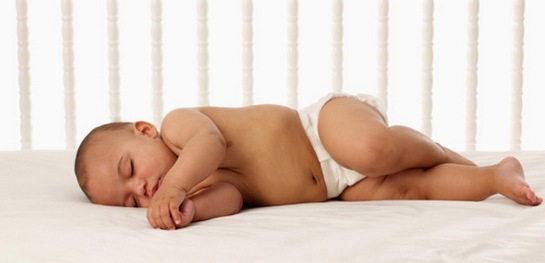
Many parents are interested in the question: a mattress for a newborn - which one is better to choose from the point of view of orthopedics? In fact, due to the small weight of the child in the first months of life, not a single mattress gives an orthopedic (supporting) effect. However, he is not needed. It is important that the baby sleeps on a flat, fairly hard surface. So his spine will be in an anatomically correct position. Pillows and soft duvets are not allowed.
What mattress is best for a child over 3 years old to sleep on? As the child grows older, it is possible to move on to fillers that provide medium rigidity, as well as to orthopedic structures with independent springs or springless.
French neonatologists have developed new model mattress suitable for babies of the first 3-4 months of life, –
cocoon. It's made from soft materials repeating the shape of the body. Such a mattress helps to relieve muscle tone, improve blood flow and prevent colic. 
Mattress in the stroller
A stroller mattress is an optional but useful accessory. It makes staying in it more comfortable for the baby, acts as a heater in winter, and also protects the cover from pollution. Some models of "vehicles" are initially equipped with "mats".
When thinking about how to choose the right mattress for a newborn in a stroller, you need to take into account such nuances as:
- a sufficient level of rigidity and orthopedic products;
- environmental friendliness, breathability, moisture resistance, hypoallergenicity of the filler and cover;
- ease of care;
- compliance with the dimensions and model of the stroller.
Since the requirements for thermal conductivity differ at different times of the year, it is worth giving preference to double-sided models that combine linen and wool, coir and latex. It is desirable that the mattress be covered with a waterproof removable cover. This will make regular cleaning easier.
bathing mattress
Another question that worries parents: what mattress to choose for a newborn for bathing, and is there a need for it? In many families, bathing a baby is an event in which almost the entire household participates. One adult holds the baby tightly, the other lathers, the third pours warm water. If a child is bathed by one parent, or he is afraid to dive into the water, a special mattress is a valuable acquisition.
The cover is made of polypropylene, polystyrene in the form of balls is used as a filler. The baby should be laid on the mattress. At the same time, his body will sink under the water, and the head, located on the pillow, will remain on the surface. 
Mattress care
In order for the mattress to serve for a long time and not lose its properties, it must be properly looked after.
- it can only be transported in a horizontal position, otherwise metal elements may move;
- water must not be allowed to enter;
- the bed should be periodically vacuumed and ventilated, knocking out is unacceptable.
Care tips for springless mattresses:
- you should regularly turn over, vacuum and ventilate the “litter”;
- air dry only.
- it is not recommended to use a hair dryer and an iron so as not to deform the filler;
- if the mattress is heavily soiled, it is advisable to take it to dry cleaning;
- when washing a removable cover or mattress pad, use baby powder and rinse the fabric well.
A quality mattress for a newborn is a must. A full-fledged comfortable sleep depends on its properties, providing a good mood during waking hours, as well as the correct formation of the musculoskeletal system. In the first months of life, the bed should be hard, breathable, hypoallergenic, natural, and also resistant to moisture and the growth of pathogens. The ideal option is a springless mattress filled with latex coconut coir, with a jacquard cover. Before buying, it is very important to verify the authenticity of the materials by examining the quality certificate.
tweet
plus
Taking care of a newborn is a difficult and responsible task. Parents need to provide for many different details and nuances in order to provide the baby with comfort, health and proper development in the future.
What mattresses are best for newborns, what to look for?
The organization of the child's bed requires special attention, because up to a year he spends almost all the time lying in the crib.
But how to choose a mattress for a newborn among hundreds of offers?
What is the best mattress for a newborn? This issue immediately appears on the agenda, but do not rush to purchase the first model that comes across in order to quickly cope with the task.
You do not like to sleep on an uncomfortable surface, and the baby will not like a bad mattress even more so.
- The mattress should fit the size of the crib or be a couple of centimeters smaller in size. If the openings between the sides and the mattress are too large, then the arms and legs of the child may get stuck in them;
- The filler should be natural, moisture resistant and comfortable;
- The presence of springs is a plus only for models for a child from two years old;
- Rigidity should be at the optimum level. The spine of a newborn is not yet fully formed., so it must be maintained in a level horizontal position;
- It is desirable that upholstery fabric was natural(linen, wool, cotton), then it will breathe and will not irritate the baby's skin.
Springs: to be or not to be?
Children's mattresses come in two types: with and without springs. What is the difference?
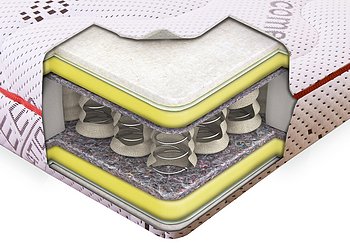 A mattress on an independent spring block should be chosen for children from 2 years old
A mattress on an independent spring block should be chosen for children from 2 years old Mattresses can have separate and independent blocks of springs. The first option is not particularly convenient: several adjacent springs are pressed through, and therefore dents form. Models with springs have a wonderful orthopedic effect, and therefore the baby sleeps in the most comfortable position.
But in newborns, the back is not yet developed, they need to provide a flat surface that will not slip. That's why spring mattresses are suitable only for children from two years old.
It is quite another thing - springless mattresses, which are made of layers of fillers. They are more rigid and therefore suitable for newborns. Used for filler different types materials.
Appearance is not important
Everything is clear with the upholstery of the mattress: it should be made from natural fabric. But with the internal content, everything is not so simple.
Let's try to figure out what types of fillers exist and why they are good.
From coconut fibers (coconut coir)
 A mattress made of the so-called coconut coir (fiber) is simply created for newborn babies, because they do not rot at all, do not wrinkle, while they are hypoallergenic and have a bactericidal effect.
A mattress made of the so-called coconut coir (fiber) is simply created for newborn babies, because they do not rot at all, do not wrinkle, while they are hypoallergenic and have a bactericidal effect.
However, the needle-punched fiber will quickly begin to crumble - it is best if the fiber is impregnated with natural latex.
Latex
 Such a mattress is already softer, and therefore will useful for older children.
Such a mattress is already softer, and therefore will useful for older children.
If you choose a double-sided mattress, for example, with coconut fibers and natural rubber, you will be able to provide your little one with a perfect sleep.
Horsehair
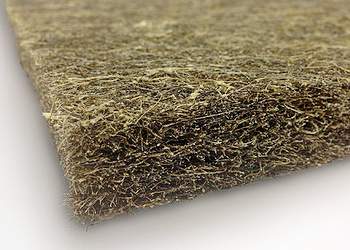 A mattress filled with horse mane and tail hair has many benefits, which you can see in the table.
A mattress filled with horse mane and tail hair has many benefits, which you can see in the table.
But unfortunately, such models are considered elite, their cost is out of the budget range.
Therefore, not all families can afford such mattresses for newborns.
From polyurethane foam (PPU)
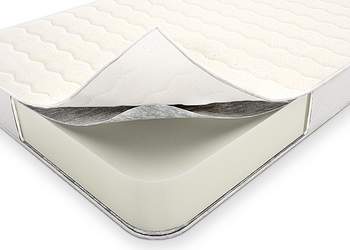 Many do not trust such models, believing that artificial filler is always worse than natural.
Many do not trust such models, believing that artificial filler is always worse than natural.
But in vain. In the public sector, they will give odds to other options.
So you could say a few years or more ago, now, using modern technologies and materials, you can get a high-quality, environmentally friendly product.
From foam rubber and cotton wool (synthetic winterizer)
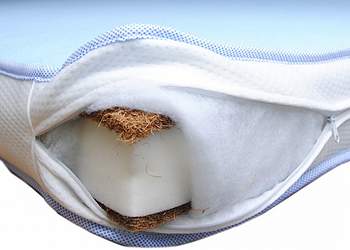 Such mattresses least suitable for newborns and children.
Such mattresses least suitable for newborns and children.
A cotton and foam mattress does not last a long time, and there are several reasons for this: the accumulation of moisture and bacteria inside, denting, rolling of the material.
This option has the right to life if the family budget is limited. In defense, we can say that earlier mattresses were made from just such materials and more than one generation grew up on them.
Sticking to the golden mean
Take mattresses in the crib for newborns of domestic or foreign manufacturers, it's up to you. Now the leading positions in the market are occupied by: Shvedeks, IKEA, Toris, DreamLine, Lonax, Serta, Askona, Rayton, Mediflex, Vegas, Pirelli and other brands.
Let's analyze mattress models by price categories, because parents first of all look at whether they can afford to fork out for certain types.
- The cheapest options(up to 1500 rubles) are mattresses made of holofiber, batting, synthetic winterizer and polyurethane foam.
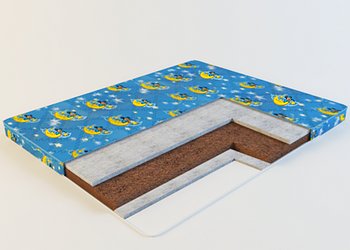 Relax Baby Natural from holofiber and coconut coir
Relax Baby Natural from holofiber and coconut coir The Shvetex Coconut Holo model made of coconut slab, synthetic winterizer and holofiber will cost 800 rubles. It is well ventilated and does not retain moisture. Dimensions 120x60 cm.
Vissa Slapna from IKEA for 500 rubles. completely composed of PPU. He is light, has standard sizes and natural linen upholstery. But it is unlikely to be tough enough for babies.
The most optimal in this price category will be Relax Baby Naturel (1150 rubles) from holofiber and coconut coir. Dimensions 120x60 cm and thickness from 6 to 14 cm provide rigidity. The materials are waterproof and safe.
- In the middle price range(from about 1500 to 5000 rubles) you can already find spring mattresses and serious models with multilayer natural fillers.
Mattress model Rysenok for 3800 rubles. has independent spring blocks, coconut coir in the composition and dimensions 120x60 cm. Optimal for children over 2 years old.
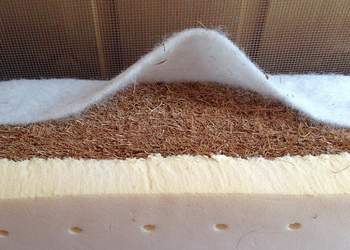 The Plitex Comfort-Elite model from the middle price range is ideal for newborns
The Plitex Comfort-Elite model from the middle price range is ideal for newborns Plitex Comfort-Elite is suitable for babies because it is double-sided. Inside there are layers of coconut, artificial latex and batting. Price 2800 r. for such a model is fully justified. Dimensions 119x60 cm.
Vissa Somnath (IKEA) for 4700 rubles. made of polyester and synthetic wool - an option only for older kids, since these are not the most "friendly" materials for children's skin. But it is very durable and well ventilated.
- Elite class mattresses from 5000 r. made from horse hair, coconut fiber and seaweed. However, this is far from a guarantee of superior quality.
Spring GameLand for 7000 rubles. from coconut coir and cotton fiber - a guarantee of environmental friendliness and comfort. Dimensions are standard, with the exception of a height of 18 cm - this is only suitable for older children.
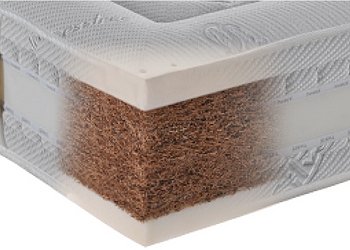 Due to the softness of the bed, the Toris Nest is not suitable for newborns, but is well suited for older children.
Due to the softness of the bed, the Toris Nest is not suitable for newborns, but is well suited for older children. Toris Nest for 13-16 tr. consists of coconut and natural latex, available in 120x60 and 140x70 variations, environmentally friendly and hygroscopic.
Everything would be fine, but it is soft, and therefore not suitable for newborns, but.
Consul Premier horsehair mattresses cost between 20-30 tr, equipped with springs.
However, they have too big sizes(length from 200 cm) and, apparently, these are practically not produced for newborns.
Summing up
We determine which mattress is best for a newborn, based on price and properties. After analyzing the table, we hope that we have answered the question: which mattress is best for a newborn.
|
pros |
Minuses |
Who suits? |
|
|
Up to 1500 r. |
Low price; A light weight; Convenient transportation. |
Poor moisture resistance; fragility; No orthopedic effect. |
Children from two to three years old. |
|
1500-5000 rubles |
The optimal combination of natural and artificial materials; Most mattresses are double-sided; Excellent orthopedic effect due to rigidity. |
It is necessary to take into account the environmental friendliness and hygroscopicity of materials - this is not taken into account in all models. | All children and newborns. |
|
More than 5000 r. |
Natural and safe materials; High orthopedic qualities (but not always for babies). |
High price; Large mattress height; Some materials cause allergies. |
Any models for children from 2-3 years. For newborns, only hypoallergenic and hard fillers. |
Care: it's easier than you think
For a durable mattress, please follow these guidelines:
- Turn it over from time to time both sides and headboard;
- Put on a protective waterproof cover;
- Clean only according to the enclosed instructions.
Now you know how to ensure a comfortable sleep for your baby and carefree nights for yourself. A properly selected mattress guarantees the child not only a good rest, but also the correct development of the spine.
In contact with
The imminent birth of the baby means that it's time to go shopping and buy all the essentials that the child will need. The most important thing is to get a crib, a good mattress and bed linen. What is the best mattress for a newborn? In this matter, many young parents make many mistakes.. Therefore, we decided to write detailed instructions choosing the best baby mattress.
In our review, we will consider all the most popular types of children's mattresses, talk about the properties of stuffing materials, and touch on issues of rigidity. In conclusion, recommendations from pediatricians will be given, which is also very important when choosing a mattress for a newborn.
Types of mattresses for newborns
Which mattress to choose for a newborn in a crib? This is a question many young parents are wondering. It is generally accepted that it is best to sleep on a soft surface - it is comfortable, lush and warm. And such concepts are fundamentally wrong, since a newborn baby should sleep on a hard bed This ensures proper development of the spine.
But before talking about the rigidity of mattresses, we should talk about their varieties. In our review, we will touch on the following types of mattresses:
- Springless;
- Spring;
- Double-sided;
- Mattresses-cocoons.
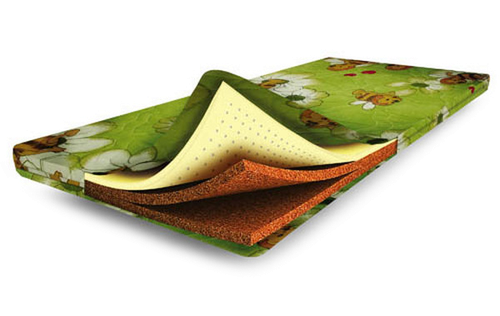
Springless mattresses
Simple springless mattresses for a crib will be the best choice. Their design does not provide for any springs, so they are absolutely safe. The basis of such mattresses are plastic fillers with different levels of elasticity. In addition, some models have orthopedic properties - this allows you to ensure the correct development of the spine and skeletal system.
Modern springless mattresses for children are made of hypoallergenic materials and equipped with dense covers made of natural fabrics. Thanks to this, children sleep in a safe environment, on a fairly comfortable and dense surface. Also, when developing children's mattresses, attention is paid to the properties of the stuffing - they must retain heat and remove moisture well. The presence of excellent ventilation properties is a solid plus, because the child must sleep in a relatively dry atmosphere, without excess moisture.
Going a little ahead, we can say that it is springless mattresses that are the best choice for a crib. They are comfortable, practical, withstand physical activity well, do not cause allergies and provide a suitable surface for a healthy and comfortable sleep.
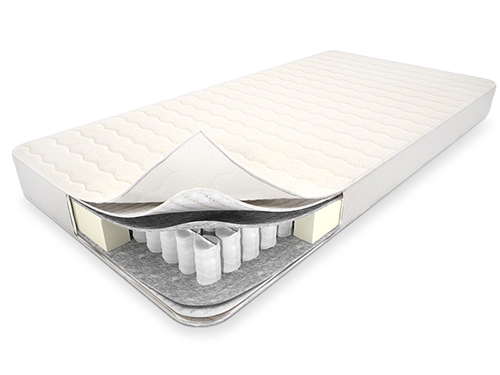
Spring mattresses
Spring mattresses for children are divided into two categories - these are classic spring mattresses and mattresses with independent spring blocks. The first category is completely unsuitable for children's sleep. Classic spring mattresses form a highly sagging surface that harms the children's spine and does not contribute to it. proper development. It is not surprising that scoliosis develops in children after sleeping on such mattresses.
As for mattresses with independent spring blocks, they are absolutely safe. They have orthopedic properties, provide good back support and can adapt to the shape of the body. But all this splendor is crossed out by one drawback - spring mattresses with independent spring blocks are not suitable for newborns. But older children can sleep on them - from about 12 years old.

Double sided mattresses
Double-sided mattresses for newborns are versatile options. They have two surfaces at once, used for sleeping. One side of them is hard, just right for newborns. As for the second side, it is of medium hardness - for older children, from three years. Why this is necessary - will be said a little later. There are also double-sided mattresses with a different aspect ratio. For example, one side can be soft and the other side can be medium hard.
Close relatives of double-sided mattresses with different levels of firmness of the sides are two-season mattresses. They are made in such a way that one side of them retains heat well, and the second is freely blown, providing a comfortable environment for children's sleep.
Double-sided mattresses are made from a wide variety of fillings, such as coconut fiber and latex, polyurethane foam and struttofiber. Some models contain blocks of independent springs, but they are not suitable for newborns to sleep.

Cocoon mattresses
Cocoon mattresses are the development of French neonatologists. They have an oval shape, and their inner part is somewhat deepened, creating a cozy space for sleeping and relaxing for the child. Thanks to this design, the body of the newborn is supported from all sides at once, as it happens in the womb.
A cocoon mattress for newborns is often equipped with fasteners and carrying handles. This ensures the safety of children and allows you to easily transport the cocoon. from place to place. That is, this is not a full-fledged mattress, but some addition that can be installed anywhere. The baby can sleep in a cocoon for up to four years, after which it should be transferred to the main mattress.
Cocoons provide soft support for the spine, slightly bending it - it is in the same position as in intrauterine development. According to French neonatologists, this position is the most optimal - the spine develops more correctly and harmoniously. In addition, a slightly arched back helps to normalize muscle tone and reduce colic.
What is the best mattress firmness?

Newborns should sleep on a fairly hard surface or on a medium firm mattress. At the same time, many parents are of the opposite opinion that the child needs a soft and comfortable bed. This is fundamentally not the case, because on a soft surface the spine takes a concave shape. And such a bend simply interferes with the proper development of the child. If the child sleeps on a hard surface, his spine will take the correct S-shape.
Since the newborn has a small weight, you can buy a mattress of medium hardness for him. Good support will provide and stiffness "below average". Stuffing materials can be any, preferably natural and hypoallergenic. The main thing is that they provide the right level of rigidity. But avoid buying mattresses with independent box springs, since they will not be able to provide the conditions for the proper development of the spine and skeletal system.
You should not stare at inexpensive spring, foam rubber, wadded and down mattresses - they do not have orthopedic properties and are completely unsuitable for newborns. They can only cause harm to the child, giving the spine an incorrect shape.
Choosing a mattress material for a newborn
The choice of a mattress for a newborn should begin with the choice of mattress filler. As we have already said, we boldly discard spring models to the side - we stop our choice only on springless mattresses made of coconut fiber, polyurethane foam, latex and struttofiber.

Polyurethane foam is one of the most common materials for stuffing children's mattresses. Initially, it is too soft, so additional components are added to its structure, giving it rigidity. Only after that it is suitable for the production of children's mattresses. Polyurethane foam rarely causes allergies, has orthopedic properties, but retains moisture too well, which is unacceptable for a crib.
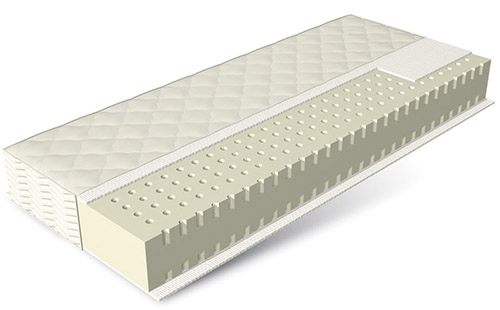
Struttofiber has a decent level of rigidity, but it is rarely used in children's mattresses. But natural latex is much more common. It does not cause allergic reactions, is well ventilated, does not create conditions for the growth of bacteria. In its pure form, it is not used due to its softness. Therefore, latex is interspersed with layers of harder stuffings, which makes it possible to create children's mattresses of medium hardness.
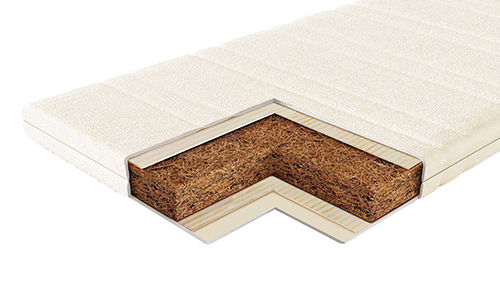
The most optimal type of stuffing for a children's mattress is coconut fiber (coir). It does not deteriorate or rot, does not support the growth of harmful bacteria, does not cause allergies, is well ventilated and retains heat. This fiber is tough, but resilient, as it is made from soaked and dried coconut rind impregnated with natural latex. Therefore, it is the best suited for creating stuffing mattresses for newborns.
Coconut mattress for newborns ideally supports the back, creates comfortable conditions for sleep and promotes the proper development of the spine. You can sleep on such a mattress from birth to three years.. From the age of three, a softer mattress should be chosen. If you want to save money, feel free to buy double-sided mattresses made of latex and coconut coir - we talked about this in our review. Until the age of three, the child will sleep on the side of coconut fiber, and after three - on the side of latex (medium hardness).
When buying a mattress, pay attention to the presence of a removable cover. Otherwise, you will have to buy a mattress pad. The best materials for covers are jacquard, spunbond.
Determining the size of the mattress
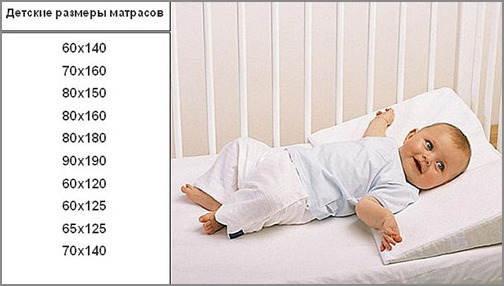
Choosing a mattress for a newborn in size does not cause any difficulties. Width and length should be such that the mattress exactly fits the crib. As for the height, it should not exceed 10 cm, the optimal figure is 5-9 cm. If the mattress is too high, then later, when the baby learns to get up, he may fall out of the crib.
For a more accurate match of sizes, it is not recommended to buy cribs of non-standard sizes - otherwise you will have to order the manufacture of a mattress according to individual measurements, which will result in a substantial amount.
Pediatricians recommend choosing mattresses of high and medium hardness for newborns. A solid foundation will allow the spine to develop as nature intended. BUT proper development of the spine is the key to excellent health of the whole organism as a whole. You should not worry that the child will experience discomfort while lying on a hard mattress. In the end, the mattress is not hard, like concrete, but resilient. Yes, and a sheet and a relatively soft cover will lie on top of it.
As for soft mattresses based on cheap foam rubber or cotton wool, their purchase should be avoided, as they can harm even an adult.
If the child has any developmental abnormalities, as well as diseases of the bone and nervous system, you should get advice from an orthopedist - he will help you choose the optimal rigidity of the mattress.
May 16, 2014, 07:02
A newborn baby spends all his time in the crib. According to pediatricians, children of this age should sleep in a calm, deep sleep for at least 16-18 hours a day. In addition, in the first months of life, the spine is formed in babies. This is why choosing the right mattress for your newborn is so important..
To date, the stores offer a huge range of children's mattresses from various manufacturers. Because of this, it is often difficult for parents to decide: “Which mattress is better? How to choose a mattress for a newborn?
What should you pay attention to when choosing a mattress for a newborn baby?
Here are a few criteria by which you should choose a mattress for your baby:
1. Mattress size
First of all, it must match the size of the crib. If you choose a smaller mattress, it will constantly move out, if it is too large, it will not be able to perform orthopedic functions. Therefore, it is necessary to carefully select a mattress for a newborn in size. The baby should be comfortable and convenient, his movements should not be constrained.
To date, the standard sizes are 120 × 60. If you received a 10-year-old crib as a gift, then it is better to measure it beforehand so as not to make a mistake when choosing a mattress.
2. Mattress firmness
Children are born with a spine that is not yet fully formed. Unlike adults, their spine does not have an S-shaped bend, it is completely straight. The curvature of the spine in children appears only by 2-3 years. That is why it is so important to choose a mattress with the right firmness for a newborn baby.
Doctors categorically forbid a child up to a year old to sleep on a soft bed in order to avoid curvature of the spine. It is best for this period of development of the child to choose a hard or moderately hard mattress.
3. Fillers for the mattress
The firmness of the mattress depends on the filler., its environmental friendliness, comfort and convenience.
The filling of a children's mattress should be mostly natural. Good kids mattressmust breathe and not cause allergies in the newborn. The filler of the mattress should not emit harmful fumes, sweat and cake. In this sense, coconut coir, cotton, batting, holofiber have proven themselves to be excellent.
Unfortunately, natural filler in mattresses is quite rare and, as a rule, these are expensive models. This is a filling with seaweed, horsehair, coconut. In cheap mattresses, this filler is combined with artificial impregnation.

But not always a natural mattress fillerFor a newborn, this is a plus. For example, six or natural latex sometimes causes allergies in children.
Such eco-friendly materials as felt, wool, wood shavings, straw, after several leaks, can begin to rot and collapse. Mattresses for newborns made of coconut flakes, despite the naturalness, quickly cake, dry out and after a while acquire a bumpy surface.
When choosing a mattress for a newborn, you should pay attention to models with coconut fiber filler. Orthopedists and pediatricians are confident that such a mattress is ideal for the development of the skeletal system of a newborn. A mattress with coconut fiber evenly distributes the load on the baby's spine and he sleeps peacefully.

The composition of coconut fiber includes a natural polymer, which is very elastic, moisture resistant and does not rot. This mattress has the right microclimate inside - it is not hot in summer and not cold in winter.
Doctors recommend coconut mattresses for babies from 0 to 12 months. They have a hard surface that is ideal for newborns. The natural filler does not cause allergies in babies, and the solid base prevents the spine from bending.
True, later, when the child grows up, you will have to shift it to a softer mattress, because pediatricians do not recommend sleeping on a hard mattress all the time.
4. Mattress surface
To choose a quality mattress for a newborn, you should also look at its outer surface. In cheaper mattresses, the cover is sewn from a simple fabric - coarse calico, chintz. Such a fabric is short-lived and wears out quickly: it is rubbed, torn, loses color.
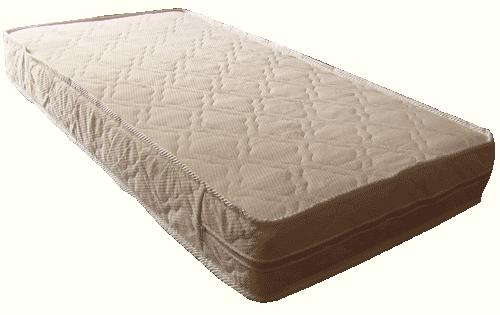
Jacquard is considered the best fabric for a cover. It consists of 70-90% natural cotton and 10-30% synthetics. A mattress with such a cover will last much longer.
Double-sided mattresses for newborns are very practical. In such mattresses, one side is made of warm materials, and the second is cooler, as it passes air well.
For the winter side, wool is usually used, which has moisture-repellent properties and is a natural insulating material. Woolen fabric perfectly retains heat, making the baby sleep in winter period calm and healthy.
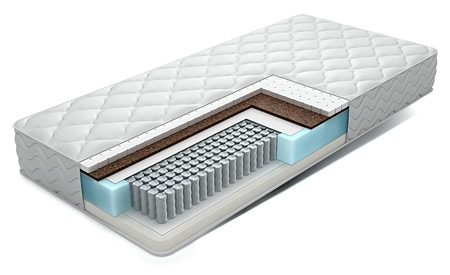
For the summer side, cotton is ideal. The jacquard used for the manufacture of the summer side of the mattress is perfectly breathable, has a non-slip surface and is moisture resistant.
Combined mattresses "winter-summer" have a latex filler for winter on one side, and coconut filler for summer on the other. Another advantage of such mattresses is their versatility. When the baby grows up, it will be uncomfortable for him to sleep on a hard surface (coconut), then you can turn the mattress over to a more elastic surface (latex).
In conclusion, a few tips for choosing and caring for mattresses for newborns:
- for better air exchange, it is necessary to use lamellar-rack bases under mattresses;
- small children (especially from 0 months old) are very sensitive to the unevenness of the bed, so the mattress cover should be made of natural materials and have as few seams as possible;
- since the baby spends all the time in his crib, his mattress should always be ventilated, clean and dry. This will prevent allergies;
- dents and bedsores on the mattress should not be allowed, as this can cause a curvature of the baby's spine;
- covers or mattress covers should always be fresh, so you need to wash them more often;
- the mattress must be periodically turned from one side to the other.
There is a new person in your house. You have already purchased a cozy bed for him, because healthy sleep For a newborn, this is the key to the health of his whole body. The most important condition for good sleep is the right mattress. The choice of a mattress for a baby should be taken very seriously.
Mattress selection options
Optimal size. It is best when the size of the mattress is a couple of centimeters shorter and narrower than the size of the crib. This will help you easily insert it into the crib, as well as remove it from there if necessary. If the size is smaller, the mattress will fidget, which will cause anxiety for the baby; a newborn can stick his finger, pen or leg into the gap between the crib and such a short mattress, which can injure him.
It is highly undesirable to choose a mattress larger than the size of the crib. It bends itself and will contribute to the curvature of the spine of the newborn. In addition, sleep on this uneven mattress will be restless. Therefore, the correct size is the first condition for choosing a mattress.
Environmental friendliness. A newborn spends most of his time in the crib, so the mattress should be as comfortable as possible and made from environmentally friendly materials that do not cause allergies. Natural fillers provide good ventilation of the product.
Hygiene. The mattress for a newborn should be well ventilated, because if moisture accumulates in it, dampness and an unpleasant odor will occur. It is best if the mattress for a newborn has a moisture-resistant coating or at least a removable cover. It is important that this cover is made of cotton and that there are no seams, zippers, etc. in the places of contact with the child's body, which can disturb the baby's sleep. The composition of the mattress also affects the hygiene index. For example, wool or felt can cause allergies.
orthopedic properties. Orthopedics ensures healthy spinal development for your child. When the child lies on a sufficiently hard mattress, his spine takes a natural position. On a bed that is too soft, the spine of a newborn can become deformed and develop incorrectly.
If you want to buy a newborn mattress for growth, up to four years old, it makes sense to buy an orthopedic one. If you rely only on early infancy, then an orthopedic mattress will not come in handy, because a newborn baby's weight is too small and the orthopedic properties of the mattress will not appear.
So, a mattress for a newborn should be of medium hardness, even and elastic, then the child's muscles will be relaxed, and the spine will take on natural curves.
Upholstery. When choosing a mattress for a newborn, give importance to the upholstery. It is best if the mattress cover is made of jacquard. Made from 80% cotton, this fabric is durable, holds color well and is easy to wash. The most comfortable covers are zippered, they are easy to remove and wash. Some mattress covers are impregnated with agents that protect against fungus, mites, dust, etc.
Mattress cover. This thing will help your mattress to last very well. long years for your children. A good mattress pad does not allow moisture to pass through, does not absorb odors and is provided with antibacterial protection. The size of the mattress pad should be slightly larger than the size of the mattress itself. This will make it comfortable to put on and it will protect the entire mattress.
Mattress types
There are two main types of mattresses on the market today, spring and springless. Below we consider in detail what advantages and disadvantages the various models have.
spring
Spring children's mattress can be with independent and independent springs. The best option is with independent springs, because if one bends, the others continue to occupy their position, and a hole does not form under the body.
Spring mattress with self-contained springs has good orthopedic properties, does not bend, like a hammock. This ensures the correct position of the baby's spine during sleep. The mattress does not creak when the child moves. However, such products also have disadvantages: due to the fact that they are quite high, the distance between the mattress by the border of the sides of the crib becomes smaller, which is why there is a danger that the baby will fall out of the crib.
If you want to choose a mattress with dependent springs, then it is better to give preference to products with small springs. The smaller their diameter, the more convenient it is for the child to move.
The spring mattress will be useful to your child and when he grows up. When the baby gains weight, the springs begin to influence the position of the child's body more significantly. The spring mattress is highly resilient and very durable: children can jump on it without damaging it.
Springless
Springless mattresses for newborns are a great alternative, they are the most purchased baby mattresses on the market. Typically, such a mattress is cheaper than a spring one. Such models consist of several layers of fabrics and fillers, while both natural and synthetic materials can be used. Consider the most popular types of springless children's mattresses.
coconut
A coconut coir mattress for a newborn is the most suitable option. Coconut fiber is sewn together with threads or bonded with latex. Stitched models are not the most suitable, since the coconut will crumble and can cause allergies in the newborn, and moreover, they quickly lose their shape, so the baby’s sleep will no longer be in the best conditions.
Therefore, it is better to choose a coconut springless mattress for newborns with natural latex impregnation. At the same time, the principle “high price - high quality” applies.
Advantages:
- high orthopedicity - coconut mattresses are very elastic, so during sleep the spine is positioned correctly, the baby feels comfortable and sleeps soundly;
- does not absorb moisture and smell;
- well ventilated;
- coconut fibers do not cause allergies;
- the product does not rot, harmful microbes and insects do not start in it.
Children's mattresses made of pressed horsehair
In terms of quality, such models are almost as good as coconut ones. For their manufacture, latex impregnated horsehair from the mane and tail is used.
Advantages:
- high strength and flexibility, retain their shape for a long time;
- moisture resistant;
- have high orthopedic;
Disadvantages:
- high price;
- the possibility of allergies;
Latex baby mattresses for newborns.
This a good option for a growing baby, but for a newborn, such a model will be too soft. Therefore, manufacturers of mattresses for newborns make two-sided models: on the one hand, coconut filler, and on the other, latex. When the baby grows up a little, you can turn the mattress over to the softer side.
Advantages:
- high elasticity, the product withstands heavy loads and easily restores its shape;
- not attractive to insects, mold and harmful microorganisms;
- does not cause allergies;
- not electrified;
- never creaks.
Disadvantages:
- at first there is some smell of rubber;
- too soft for newborn babies;
Wadding or foam children's mattresses
This is the worst mattress for newborns. Batting and synthetic crumb are not natural materials, and products made from them are too soft, so there is a risk of acquiring scoliosis or other diseases of the spine. Such mattresses absorb moisture, smell and deform. The liquid absorbed into the fabric provokes the development of mold and harmful microorganisms.
However, if you properly care for the product, some problems can be avoided. It is necessary to prevent the mattress from getting wet (for example, put an oilcloth under the baby), dry it, straighten it so that it does not stray. These mattresses are the cheapest and easy to transport. But, if funds allow, it is better to buy an expensive, but high-quality product in order to preserve the health of your baby.
